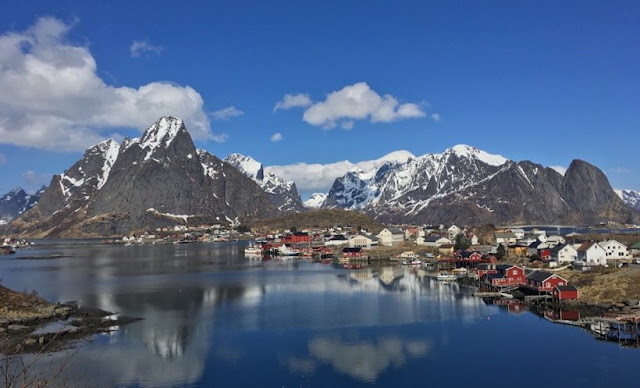Lofoten geography and history
The first people came to Lofoten over 7,000 years ago. During the Stone Age, people made a living out of fishing and hunting. The Lofoten was covered with large pine and birch forests. There were deers, bears, reindeers, lynxes and beavers and the sea was full of fishes, seals and whales. Agriculture developed early. As early as 4,000 years ago, grain was harvested in Lofoten.
The Viking Age saw the emergence of several large chiefdoms. At Borg, in Vestvågøy, some remains of a chiefdom were found with the largest banquet hall known from the Viking era throughout the Nordic region. The building was 8.5 meters wide and 83 meters long. A reconstruction of the building was done at Borg. The Viking Museum at Borg is now open since June 1995. By Kabelvåg, there is a small town called Vågar which was the largest township in the North of Skandinavia during the Middle Ages.
The Lofoten Fisheries has been an important part of the Lofoten history. In year 860, King Alfred of England, wrote about stockfish that the Viking Ottar brought from Vágar in Lofoten. For King Øystein, fishing was so important that in 1107, he built a church in Storvågan, which was then the center of the Lofoten Fishery. He also built the first fishermens cabins that are mentioned in the saga, in the year 1120. Stockfish, produced from spawning cod was the most important production, and it was pretty much all over Europe. Italy is still the most important market for high-quality stockfish from Lofoten.
From the 1300s on, Lofoten paid taxes to Bergen. This was the beginning of a 600-year-long economic dominance, first exercised by the Hanseatic League, and later by their Norwegian executors. Changing times of famine and poverty were succeeded by periods of good years and great wealth. From the 1860s, came the great herring migrations that became the basis of growth, prosperity and immigration. The basis of today's settlement was established.
_____________________________________________________
Lofoten’s history revolves around fish. The population has always fished all year round, usually alongside running small farms. Yet it is the seasonal fishing for Norwegian cod that has been of the greatest importance. Every year from January to April, large numbers of skrei (Norwegian Arctic cod) migrate from the north to the marine areas around Lofoten in order to spawn. The fisheries that take place during these months have provided a living for the local people for centuries.
In Lofoten, we have found evidence of Stone Age people who subsisted on fishing 6000 years ago. Finds have revealed that they used fishing weights and fishing hooks made from bone and horn. The area’s natural resources also formed the basis for one of Northern Norway’s largest and most powerful chieftain’s residences during the Viking Age. Borg is the site of the world’s largest longhouse, which is no less than 83 metres long. Explore the reconstructed chieftain’s house and travel more than 1000 years back in time.
Lofoten’s main fish product is stockfish. The conditions in the archipelago are perfect for naturally drying fish of the very highest quality. As long ago as the year 1100, the fishing and production of stockfish was so important that it led to the development of Vágar - the first Middle Age town in Northern Norway. The spawning fish arrived in such enormous quantities that there was more than enough to go round for the population of Lofoten. As a result, fishermen from across the whole of Northern Norway flocked to Lofoten to take part in the Lofoten Fishery. They had to sail and row great distances in open boats, often traditional Nordland boats. As many as 30,000 men would arrive during the fishery season. In the fishing villages, they would hire fisherman’s cabins for accommodation, and they would also sell their catches from there too. The traditional fisherman’s cabin dates back at least 1000 years. Find out more about this in Kabelvåg, where you can visit the local squire’s residence with its fisherman’s cabins, and experience life underwater at Lofoten Aquarium.
The fisherman’s cabins were hired out by the local squire. These squires had exclusive rights to trade and buy and dry fish. Stockfish were transported to traders in Bergen, before being sold on across Europe. Stockfish has been a vital export product which has generated substantial revenues for the Norwegian economy. Thanks to the stockfish trade, the fishing villages had economic and cultural contact with the outside world. The Norwegian Fishing Village Museum at Å in Lofoten will give youa fascinating insight into the importance of the fishing villages, through visits to many houses in the fishing village, both with and without a guide. Don’t forget the baker’s either! Stockfish has its own museum in Å. The Norwegian Telecom Museum in Sørvågen presents the fascinating history of communication. The history of the fisherman-farmer is also worth taking in, and a visit to Skaftnes farm in particular is recommended.
The unique nature and strong cultural traditions of Lofoten have attracted many artists. Over the past 150 years, Lofoten has been portrayed by artists in a huge variety of genres and there are many art galleries and craft outlets in the area. Kaare Espolin Johnsen, one of Northern Norway’s celebrated artists, chose to set up his gallery in Kabelvåg.
Fish are still important in Lofoten to this day. The fishing methods, production processes and fish sales may all have changed, but the principal product remains the same: skrei/ cod and stockfish. In Lofoten, you can get close to history. You will find fisherman’s cabins and fish drying racks side by side with modern technology in modern settlements. Track down the history and prepare to be amazed by the scope of the fisheries and the importance of skrei.


















